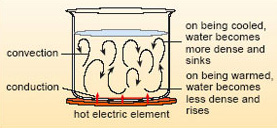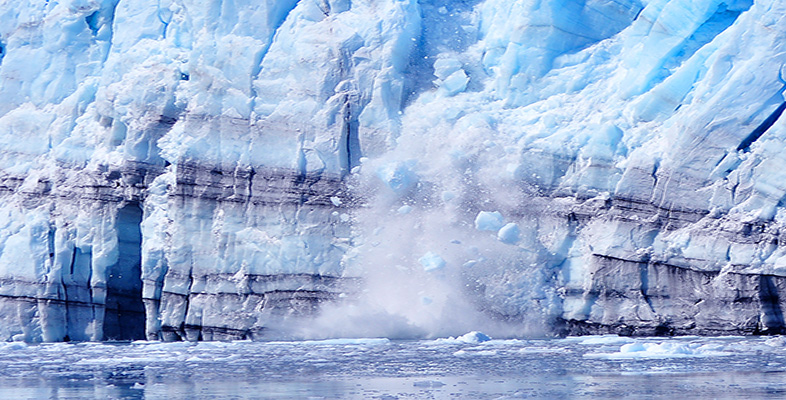1.3.4 The role of convection in the atmosphere
We come now to our final refinement to the simple picture in Figure 7. Recall that the troposphere is heated from below, with temperature then falling with increasing altitude. This situation sets the scene for the onset of convection - the bulk flow or circulation of a fluid driven by differences in temperature. Convection in the atmosphere plays a vital role in two further mechanisms - quite apart from the emission of longwave radiation - whereby energy is transferred from the Earth's surface to the atmosphere.
The first is the transfer of 'thermal' energy (often referred to rather loosely as 'heat') by a combination of conduction and convection. This is essentially the same mechanism that heats a saucepan of water on the stove; see Box 4. The situation in the atmosphere is more complicated, but the basic principle is the same. Warm air, heated by contact with the ground or a warm sea, rises upwards carrying heat transferred from the surface aloft. This allows more cool air to come into contact with the surface and be heated in its turn. Working together, conduction/convection drive a significant flow of heat across the boundary between the surface and the air.
Box 4 Heating water by conduction and convection
Anyone who tries to pick up a metal spoon left in contact with a hot pan quickly learns that metals are good conductors of heat. Conduction is the transfer of heat through matter by molecular activity; i.e. the energy is transferred through contact between individual molecules. By contrast, convection is the transfer of heat by bulk movement or circulation within a fluid (a liquid like water or a gas like the air).
In Figure 11, heat is transmitted from the electric element, through the pan to the water in contact with the base of the pan by conduction. As water in this layer warms up, it expands - this is called thermal expansion - and so becomes less dense than the water above. Because of this new buoyancy, the warm water begins to rise, to be replaced by cooler, denser water from above which is heated in its turn. On reaching the surface, the warmed water begins to lose heat to the air; it cools, becomes denser and sinks, then is heated again and rises, and so on. As long as the water is heated unequally (i.e. from the bottom up), the water will continue to 'turn over' in a convective circulation so that eventually all of it becomes warm.

The second form of energy transfer is indirect, but even more important on a global scale. It involves the evaporation of water - mainly from the oceans, but also from lakes and rivers, soils, rocks and vegetation on land. Evaporation requires energy, known as the latent heat of vaporisation, which is extracted from the surface involved. This is why the evaporation of sweat acts to cool the body. The latent heat of vaporisation of water, i.e. the amount of heat needed to convert 1 kg of liquid water to water vapour at the same temperature (and the amount of heat released to the surrounding environment when 1 kg of water vapour condenses) is 2.25 × 106 J kg−1 - higher than the value for any other substance.
SAQ 10
How does convection in the overlying air help to promote the evaporation of water?
Answer
Convection carries air containing water vapour upwards, so the air just above the surface does not become 'saturated' (Section 1.2.2), enabling more water to evaporate.
As we noted earlier, the saturation limit of air depends on temperature: cool air can carry less water vapour than warm air. As moisture-laden air is carried upwards, it cools and may become saturated. Continued rise and further cooling then results in the condensation of water vapour onto aerosols in the air: clouds form and latent heat is released to the atmosphere. Clouds, the turbulence of atmospheric convection and the winds that redistribute heat around the world are largely confined to the troposphere (tropos is Greek for 'turning').
SAQ 11
Look back at Figure 9. It is often said that the tropopause acts like a lid, preventing convection in the lower atmosphere from reaching any higher. Can you suggest why?
Answer
With (less dense) warm air lying above (more dense) cooler air, conditions in the stratosphere are not conducive to convection. (Stratos is Latin for 'layered'.)
Rapidly rising air can (and does) overshoot the tropopause, mostly in the updraught of violent storms over the tropics. And there are return routes as well, mainly at middle latitudes. In general, though, the circulation of air in the stratosphere does not interact strongly with the wind systems in the lower atmosphere. It is within the troposphere that the full drama of the Earth's weather occurs.
